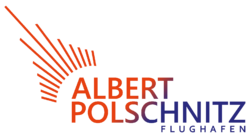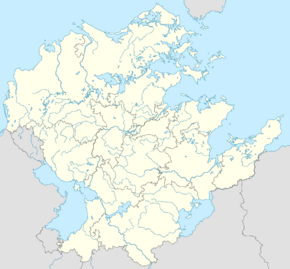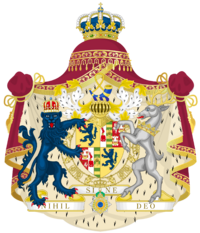Albert Polschnitz Airport
Königsreh Albert Polschnitz Airport Flughafen Königsreh-Albert-Polschnitz | |||||||||||||||||||||||
|---|---|---|---|---|---|---|---|---|---|---|---|---|---|---|---|---|---|---|---|---|---|---|---|
 | |||||||||||||||||||||||
 | |||||||||||||||||||||||
| Summary | |||||||||||||||||||||||
| Airport type | Public | ||||||||||||||||||||||
| Owner | KönigsrAIR AG | ||||||||||||||||||||||
| Operator | Königsreh Albert Polschnitz Ltd. | ||||||||||||||||||||||
| Serves | Königsreh, Mascylla | ||||||||||||||||||||||
| Location | Tülwitz, Kronlande, Mascylla | ||||||||||||||||||||||
| Hub for |
| ||||||||||||||||||||||
| Focus city for |
| ||||||||||||||||||||||
| Elevation AMSL | 113 ft / 34 m | ||||||||||||||||||||||
| Website | www | ||||||||||||||||||||||
| Map | |||||||||||||||||||||||
| Runways | |||||||||||||||||||||||
| |||||||||||||||||||||||
| Statistics (2018) | |||||||||||||||||||||||
| |||||||||||||||||||||||
Albert Polschnitz Airport (Hesurian: Flughafen Albert-Polschnitz; IATA: APS; ICAO: TRBA), officially known as Königsreh Albert Polschnitz Airport (Hesurian: Flughafen Königsreh-Albert-Polschnitz), is the largest Mascyllary international airport near Königsreh, Mascylla, and one of the largest international airports in Berea. Measured by international passenger traffic in 2018, Albert Polschnitz Airport was the third busiest airport in the world, the sixth busiest airport in the world by total passenger traffic, and the third busiest by air cargo transport. Together with Königsreh-Stadten Airport, it serves the Königsreh metropolitan region and is therefore a significant domestic and international aviation hub.
The airport is located 15 kilometres (9.3 mi) north-east of central Königsreh and named after Albert Polschnitz (1886–1980), Mascyllary statesman and revolutionary figure since 1982. In 2018, 40.1 million passengers in total arrived at Albert Polschnitz Airport. With over 540,000 metric tonnes of cargo, the airport also had the third largest freight volume out of all airports worldwide. Albert Polschnitz features two parallel east-west runways, two additional runways to the north-west and south-west and three terminals to support the huge influx in aviation activity.
Albert Polschnitz Airport serves as the principal hub for the national flag carrier Maskillea Airlines and its subsidiaries Maskillea Cargo logistics and Maskillea Express charter flights, as well as a focus city for various domestic and international low-cost airlines such as Jet1 and MuraAero. The airport and its adjacent facilities are operated by the KönigsrAIR AG branded as Königsreh Albert Polschnitz Limited, the major shareholders of which being the states of Shwesia, Eustria and the city Königsreh.
Location
The airport facility is located approximately 15 kilometres (9.3 mi) north-east of central Königsreh, a significant portion of which is situated in the Charlottenbad Conservation Forest (Erhaltungsforst Charlottenbad). Königsreh-Albert Polschnitz is a designated administrative neighbourhood of Königsreh with approximately 1,020 inhabitants in 2016 and a size of 20 square kilometres (7.7 sq mi), with the airport grounds themselves covering more than half of the neighborhood. The northern areas of the airport partially extend to the areas of the cities Sankt Höhge and Flammberg, while a part of the eastern facility extends into Grimelow.
Access
Albert Polschnitz Airport is easily accessible by every means of transportation, mainly due to its proximity to Königsreh and its location within the Königsreh-Flussmund Blaugold metropolitan region. It has access to a widely suffisticated infrastructure of car, rail, air and public transport.
Individual access
Since 1947, the Autobahn A4 runs eastward along the northern peripheries of the airport, and the A11 along its eastern peripheries since 1960. Both highways intersect at the Königsreher Kreuz in immediate proximity to the airport terminals, being one of the busiest road nodes in Berea with a 2016 daily traffic of 177,000 vehicles. The Herrsstraße H23 runs parallel to the A11, containing most of the airport's arriving passenger traffic and running along a northern axis Grimelow, Flughafen, Flughafen-Cargo and Tülwitz. The southern areas of the airport are accessible through the junction Edgeheim of the A11. Additionally, numerous taxi companies provide flat rate services independent from the length of distance or the amount of passengers; services for carsharing are also provided by the airport at Terminal 2.
Public transport
The airport is connected to the railway system of Mascylla by two train stations: the Regionalbahnhof Flughafen in front of Terminal 1 provides access to Regionalexpress, Regionalbahn and S-Bahn traffic via the lines S9 and S10, and the Fernbahnhof Flughafen between A4 and H92 and connected to Terminal 1 by a roofed bridge provides inter-city rail transport to major Mascyllary train stations such as Königsreh Hauptbahnhof, Flussmund Hauptbahnhof or Langquaid Hauptbahnhof. Furthermore, the airport is linked to the public transport bus service of the local and regional networks. The bus line 169 links the airport to the Bahnhof Könisgreh-Zollernhöh and operates stops at Maskillea Aviation Center and Maskillea-Hub. Passengers who are not arriving at the airport by car or public transport can use numerous ways of airport transfers, including the shuttle bus FlyLiner. Hotels near the airport also provide private transfer systems.
Airport facilities
Terminals
Albert Polschnitz Airport currently operates three large terminals with six main halls, a terminal for private aircraft, a specialized cargo terminal and an additional terminal for frequent-flyer and first-class passengers of Maskillea Airlines. The fourth large passenger terminal to the south-east of the airport is as of 2020 in active construction development. The airport rail transport Skyway connects the passenger terminals with stops at gates A/B (only for national and international passengers) and C/D (additionally for visitors) in Terminal 1, gate E (only for international passengers) in Terminal 2, and gates F/G and H/I in Terminal 3.
Terminal 1
Terminal 1 hosts the entirety of the flights of Maskillea Airlines as well as its subsidiaries (Maskillea InLand, Maskillea Express, X) with its four passengers gates A, B, C and D. Additionally, airlines without links to Maskillea are dispatched at Terminal 1 as well mainly due to individual agreements with the airport out of operational necessity, most notably X. Terminal 1 is also the only terminal with the capability of dispatching X.
It is the oldest and second largest main terminal with a capacity of approximately 10 million annual passengers and a floor area of 46,574 m2. The terminal was originally referred to as Terminal Welthafen to differentiate it from Terminal 2, then known as Terminal West, and to pronounce its importance as terminal of Interflug, the flagship carrier of Mascylla throughout much of the 20th century. The old airport tower, operating from 1961-1980, was integrated into the terminal building and is now retired as a publicly accessible viewing platform. The terminal was first opened to the public in 1961 and utilized among the world's first fully automatic airport baggage handling system; Due to its facility length, capacity, performance and statistical reliability it is widely considered unique. From 1990 to 1997, Terminal 1 was thoroughly modernized and extended: gate D was added by a new building to the west, the transition bridge between Terminal 1 and Terminal 2 was extended, and the gates B-Nord and B-Ost were rebuilt. The A, B, C and D departure halls were renovated with new spaces for gastronomy and shopping, and a complex for customs enforcement adjacent to gate A was erected.






